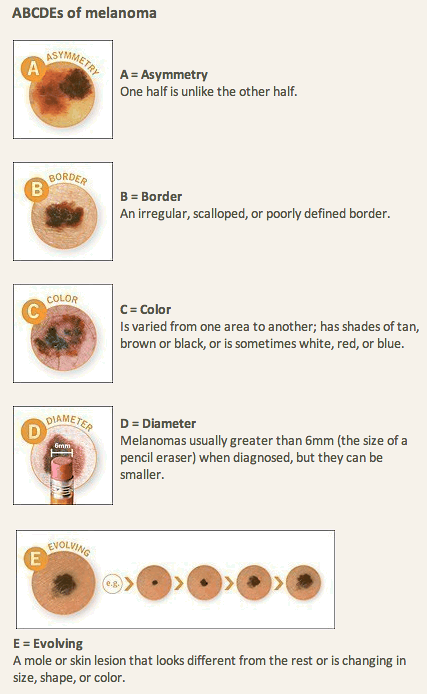Moles (Nevi)
- Acne
- Acne Scars
- Benign Growths
- Red Birthmarks
- Excessive Sweating (Hyperhidrosis)
- Melasma
- Melanoma
- Moles (Nevi)
- Pre-cancers (Actinic Keratoses)
- Rosacea
- Acne Scarring
- Skin Cancer
- Brown Spots & Freckles
- Total Body Photography
- Veins
- Wart Removal
- Wrinkles
- Cherry Angiomas
- Enlarged Pores
- Redness of Neck or Chest
BENIGN MOLE
A mole is a common skin growth than can be flat or bumpy and can be skin colored, tan, or brown. Almost every adult has a few moles.
What should I look for?
It’s important to take time to look at the moles on your skin because this is a good way to find melanoma early. When checking your skin, you should look for the ABCDEs of melanoma.
View ABCDs of Melanoma
Source: AAD.org
Treatment
If the dermatologist finds a mole or other spot that looks suspicious, the dermatologist will remove it (or part of it) by performing a biopsy. The removed skin will be sent to a lab for a skin pathologist to read. Only after the biopsy has been interpreted can a diagnosis be made. If the biopsy reveals a mole that is atypical or abnormal, the mole will be removed in the office by surgical excision with appropriate margins.
ATYPICAL MOLE (DYSPLASTIC NEVUS)
Atypical moles can appear anywhere on the body. They often appear on the trunk. And they may appear on the scalp, head, and neck. Atypical moles rarely appear on the face. Unlike typical moles, they are often larger than 6 mm (size of pencil eraser), have an odd shape (not round), and have more than 1 color (mixes of tan, brown, red, and pink). You have a higher risk of getting melanoma if you have
- 4 or more atypical moles.
- Already had a melanoma.
- A first-degree relative (parent, brother, sister, or child ) who had melanoma.
Some people who have many atypical moles have a medical condition called familial atypical multiple mole-melanoma (FAMMM) syndrome. People with FAMMM syndrome have many moles (>50), some moles that are atypical, and history of a blood relative with melanoma. We offer Total Body Photography for patients with a large number of atypical moles.
CONGENITAL MOLE (CONGENITAL NEVUS)
When a person is born with a mole, the mole is called a congenital mole. Roughly, 1 out of 100 people is born with a mole. These moles vary in size from small to giant. Having a giant congenital mole increases a person’s risk of developing melanoma. Congenital moles should be evaluated by a dermatologists and, if indicated, surgically excised. Dr. Curcio specializes in Skin Cancer Surgery. In addition, she has extensive experience in cosmetic and laser surgery and can help you attain the best possible outcome in treating your post-operative scar.
Dr. Curcio’s Reconstructive Skills are Truly Remarkable
I was diagnosed with Melanoma in Situ at the age of 51. Needless to say I was frightened and overwhelmed by the diagnosis. I am so thankful that I found Dr. Curcio (in 2012) at that time! She performed “Slow” Mohs surgery and reconstruction on my lower leg. Not only did she spend time with me explaining every aspect of the treatment, but her warm and caring manner immediately put me at ease during a very emotional time.
The surgery was quite extensive and successful (I am still cancer free!), but I have been absolutely amazed by the lack of scarring. Dr. Curcio’s reconstructive skills are truly remarkable.
I can’t say enough about my great experience with Dr. Curcio and her combination of professional excellence and personal compassion. She is simply the best!










